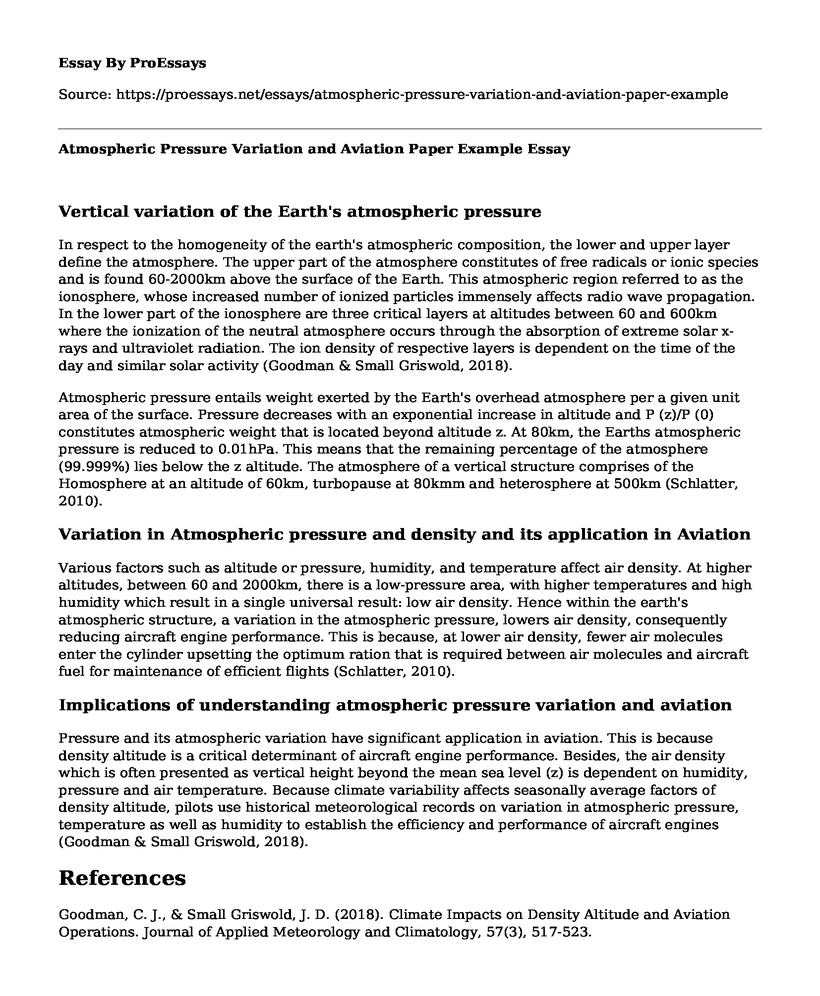Vertical variation of the Earth's atmospheric pressure
In respect to the homogeneity of the earth's atmospheric composition, the lower and upper layer define the atmosphere. The upper part of the atmosphere constitutes of free radicals or ionic species and is found 60-2000km above the surface of the Earth. This atmospheric region referred to as the ionosphere, whose increased number of ionized particles immensely affects radio wave propagation. In the lower part of the ionosphere are three critical layers at altitudes between 60 and 600km where the ionization of the neutral atmosphere occurs through the absorption of extreme solar x-rays and ultraviolet radiation. The ion density of respective layers is dependent on the time of the day and similar solar activity (Goodman & Small Griswold, 2018).
Atmospheric pressure entails weight exerted by the Earth's overhead atmosphere per a given unit area of the surface. Pressure decreases with an exponential increase in altitude and P (z)/P (0) constitutes atmospheric weight that is located beyond altitude z. At 80km, the Earths atmospheric pressure is reduced to 0.01hPa. This means that the remaining percentage of the atmosphere (99.999%) lies below the z altitude. The atmosphere of a vertical structure comprises of the Homosphere at an altitude of 60km, turbopause at 80kmm and heterosphere at 500km (Schlatter, 2010).
Variation in Atmospheric pressure and density and its application in Aviation
Various factors such as altitude or pressure, humidity, and temperature affect air density. At higher altitudes, between 60 and 2000km, there is a low-pressure area, with higher temperatures and high humidity which result in a single universal result: low air density. Hence within the earth's atmospheric structure, a variation in the atmospheric pressure, lowers air density, consequently reducing aircraft engine performance. This is because, at lower air density, fewer air molecules enter the cylinder upsetting the optimum ration that is required between air molecules and aircraft fuel for maintenance of efficient flights (Schlatter, 2010).
Implications of understanding atmospheric pressure variation and aviation
Pressure and its atmospheric variation have significant application in aviation. This is because density altitude is a critical determinant of aircraft engine performance. Besides, the air density which is often presented as vertical height beyond the mean sea level (z) is dependent on humidity, pressure and air temperature. Because climate variability affects seasonally average factors of density altitude, pilots use historical meteorological records on variation in atmospheric pressure, temperature as well as humidity to establish the efficiency and performance of aircraft engines (Goodman & Small Griswold, 2018).
References
Goodman, C. J., & Small Griswold, J. D. (2018). Climate Impacts on Density Altitude and Aviation Operations. Journal of Applied Meteorology and Climatology, 57(3), 517-523.
Schlatter, T. W. (2010). Vertical Structure of the Atmosphere. Encyclopedia of Aerospace Engineering.
Cite this page
Atmospheric Pressure Variation and Aviation Paper Example. (2022, Jul 08). Retrieved from https://proessays.net/essays/atmospheric-pressure-variation-and-aviation-paper-example
If you are the original author of this essay and no longer wish to have it published on the ProEssays website, please click below to request its removal:
- Jet Blue Airlines Essay
- The Future of the SMS in the Aviation Industry - Essay Sample
- High-Speed Flight in Aviation Essay Example
- Advantages and Disadvantages of Simulation Essay Example
- Facebook: Connecting People Globally from Big Four Tech Org.
- Child Obesity: A Growing Health Issue Affecting Nations.
- Street Drugs: Stimulants, Depressants, Opioids, Hallucinogens - Essay Example







